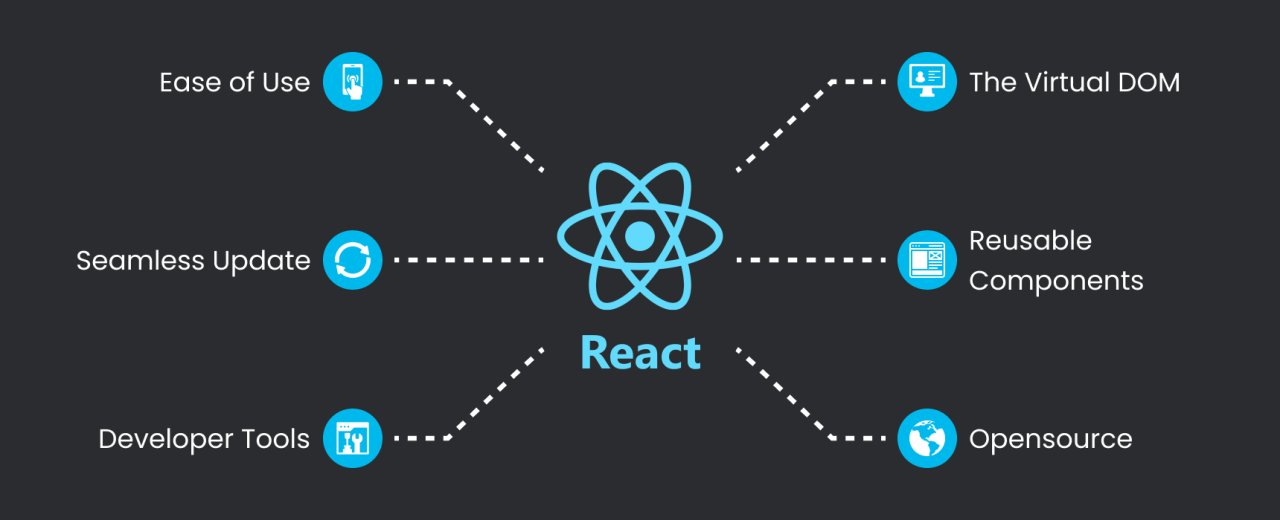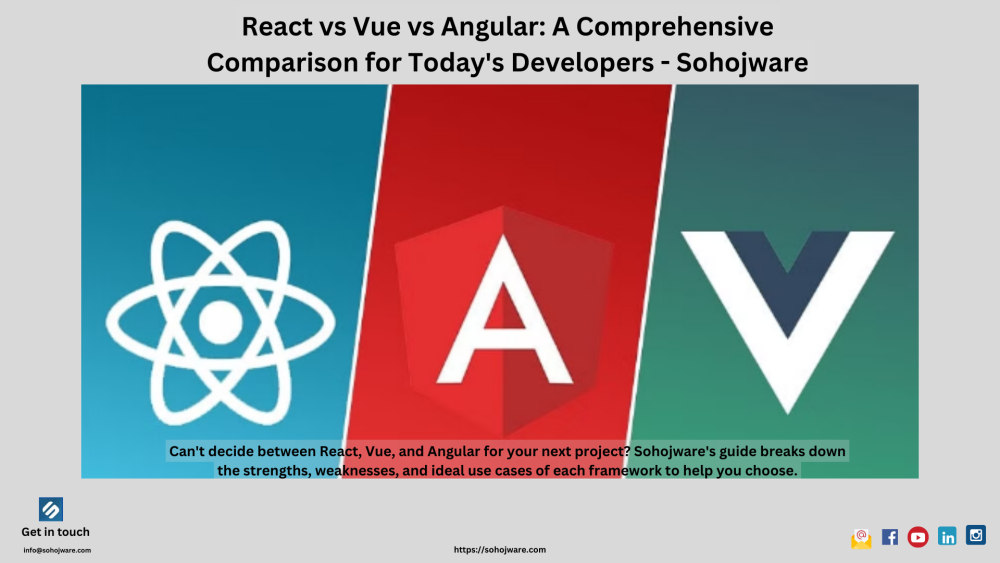In the dynamic world of web development, choosing the right framework can make a significant difference in project success. React, Vue, and Angular are three of the most popular frameworks, each offering unique features and advantages. This article provides a comprehensive comparison to help you decide which framework is best suited for your needs. Sohojware, a leader in innovative web solutions, often leverages these technologies to deliver exceptional digital experiences. Let's delve into the specifics of each framework.
We can write it without questions: in the modern world of web development, the selection of an appropriate framework can greatly influence the results of the project. Among the best-known frameworks, we have React, Vue, and Angular, each coming with its own capabilities and benefits that help streamline the development process. If you need help in deciding which framework suits you best, this article will cover all that information that may be useful in coming to a decision. These technologies can be employed to make some organizations stand out like Sohojware which is a pioneer in providing advanced web solutions. It is high time to consider what each of the mentioned frameworks implies.
Overview of the Frameworks
React

React is an open-source JS library designed for the creation of user interfaces or specific elements of a page, such as a single-page application, by the Facebook company. It is famous for its component built architecture, and Virtual DOM.
Pros:
-
Component-Based: Encourages reusable components.
-
Virtual DOM: Enhances performance.
-
Large Ecosystem: The integration is indeed packed with libraries and tools.
Cons:
Learning Curve: Another challenge that arises from the use of JSX syntax is that the syntax is relatively new and may be unknown to some users.
Dependency Management: This often has an added need for libraries to handle state management and routing systems.
Vue

Vue. js is an open-source JavaScript framework developed by Evan You and is described as progressive. It is envisioned to be incrementally adoptable and features the View layer, which enables it to be easily integrated with other projects.
Pros:
-
Ease of Use: Having a simple and intuitive API is an important criterion for a good API.
-
Flexibility: Works for equally small and broad projects.
-
Detailed Documentation: I have covered all the basics and general information about search engine optimization.
Cons:
Community Size: It is compared to other front-end frameworks such as React and Angular, but it is smaller in size.
Language Barriers: It also has some resources and plugins provided in Chinese, though the main language is English.
Angular
Angular is a client-side development platform, which also refers to as a framework that is used in building web applications using HTML templates and CSS styles together with JavaScript and Typescript languages. It is a framework developed by Google and is ideal for enterprise-scale applications because of its comprehensive features.
Pros:
-
Full-Featured Framework: Subjects all variety in one package that is suitable for larger scale applications.
-
TypeScript: Features that make Python have a strong typing include; It is faced with some of the most advanced features including;
-
Steep Learning Curve: It has been deemed complex for beginners since it encompasses a broad, fundamental concept.
Performance Overhead: Pro Can be heavier compared to React and Vue.
Key Features Comparison
Performance
-
React: The Shadow DOM is used as the primary DOM to enhance the application’s rendering, making it more efficient for dynamic applications.
-
Vue: It too uses a virtual DOM and has similar execution speed to what we have seen with React. This has made it more efficient since it is lightweight than the original complex structures.
-
Angular: However, the following are its shortcomings; Two-way data binding: Angular facilitates it, which is a plus but hampers overall performance Two- way data binding: Angular supports it, which is an added advantage, yet it slows performance compared to React or Vue Massive file size: It is relative to that of React and Vue but has a significant impact on bootstrapping and rendering times.
Scalability
-
React: It can easily scale up because of its modular design and idea of components and has a very large collection of libraries available.
-
Vue: Appropriate for both small and large projects increasing the area of its application with the increase in more compatibility for scalability.
-
Angular: As targeted at large scale applications, Angular offers a myriad of features for supporting its user’s enterprise application needs.
Learning Curve
-
React: Moderate learning curve. It might still pay to learn JSX initially owing to the challenges that it presents to a developer but on the flip side, the ecosystem and community exist to assist in the learning process.
-
Vue: Low learning curve. Though it is a simple and easy to use software, the documentation provided is commendable which makes it feasible for a beginner.
-
Angular: High learning curve. Due to the array of features and the general nature of its functions, it will take many hours to learn this tool.
Community and Ecosystem
-
React: BOASTS of having a huge community and ecosystem with massive resources and libraries together with third-party support.
-
Vue: As with many small but growing communities, residents have reported increased traffic in their neighborhoods. Less complaints and more useful plugins and tools compared to previous days.
-
Angular: Solid community around the software with plenty of resources and quite many tools officially endorsed by Google.
Use Cases
-
React: Ideal for dynamic and high-performance web applications, single-page applications, and projects requiring high scalability.
-
Vue: Great for small to medium-sized applications, prototypes, and projects where ease of integration and flexibility are important.
-
Angular: Best suited for large-scale, enterprise-level applications with complex requirements and a need for robust architecture.
Sohojware's Perspective
At Sohojware, we understand that the choice of framework depends on the specific needs of a project. Here's how we leverage each of these frameworks:
-
React: We use React for projects that require dynamic user interfaces, high performance, and scalability. Its component-based architecture aligns well with our development practices, allowing us to deliver robust and maintainable applications.
-
Vue: For projects that demand quick turnaround times and simplicity, we opt for Vue. Its ease of use and flexibility make it ideal for smaller projects and prototypes.
-
Angular: For enterprise clients with large-scale applications, we choose Angular. Its comprehensive toolset and strong typing with TypeScript ensure that we can build complex, feature-rich applications that meet rigorous standards.
React, Vue, and Angular each offer distinct advantages and are suited for different types of projects. React excels in performance and scalability, Vue stands out for its ease of use and flexibility, and Angular shines in building large-scale, enterprise-level applications.
At Sohojware, we leverage the strengths of these frameworks to meet the diverse needs of our clients, ensuring that each project is delivered with the highest quality and performance. By understanding the unique features and use cases of React, Vue, and Angular, developers can make informed decisions that align with their project requirements and goals.
To explore how Sohojware can help you choose the right framework for your next project, visit www.sohojware.com.
FAQ’s
-
Choosing the right framework: What factors should I consider?
Many aspects influence framework selection, such as project complexity, team skillset, and desired functionality. This guide by Sohojware explores the strengths and weaknesses of React, Vue.js, and Angular to aid your decision.
-
Is React the most popular framework?
React currently holds the top spot in popularity, but all three frameworks (React, Vue.js, Angular) boast strong communities and active development. Sohojware's comparison dives deeper to help you choose the best fit for your needs.
-
Is there a framework suitable for beginners?
While all frameworks have learning curves, Vue.js is generally considered easier to pick up due to its focus on core concepts and simpler syntax. Sohojware's guide provides a comprehensive overview to empower your choice.
-
What are the benefits of a structured framework?
Structured frameworks like Angular offer a well-defined architecture and built-in features, promoting code maintainability and scalability for large projects. Sohojware's comparison explores the advantages and trade-offs of each framework.
-
What's the importance of a large developer community?
A large and active community provides access to a wealth of resources, libraries, and tutorials. React boasts the biggest community, but all three frameworks have strong support. Sohojware's guide empowers you to make an informed decision.




